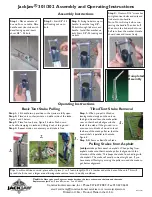
L011-51-02 (Rev. B0, 2020-07-28)
5
Notes
• We recommend the use of a high impedance, low leakage current amplifier specially designed for use
with microelectrodes.
• We recommend the use of isolated stimulators equipped with a compliance limit warning indicator.
• microTargeting™ Electrodes are properly installed and can operate correctly and safely if the directions for
use are followed.
• Electrode lead cables must have the capability of mating with 0.8±0.04mm diameter
microelectrode male pins.
• microTargeting™ pin connectors have a diameter of 0.8mm ±0.04mm and a mating length of
4mm ± 1mm.
English
WARNINGS
• Rx only: Caution-
Federal law (USA) restricts this device to sale by or on the order of a physician.
• Patients with a microTargeting™ Electrode inserted intracranially should not be exposed to the
electromagnetic fields produced by magnetic resonance imaging (MRI). Use of intraoperative
MRI may cause heating, movement, or induced voltages in the microTargeting™ Electrode.
• In the event that a patient must be defibrillated via electric shock, the microTargeting™ Electrode
should be withdrawn prior to defibrillation.
• When using differential electrodes for macrostimulation, excessive stimulus currents may result
in tissue damage. Therefore stimulus amplitude should never exceed the recommended guidelines
provided by the manufacturer of the stimulus generator. Balanced, biphasic square pulses with the
following parameters are recommended:
Frequency
≤ 300 Hz
Pulse Duration
100-200µs
Train Duration
≤ 5 sec.
Current Amplitude
≤ 10mA
• When using differential electrodes for macrostimulation, the stimulator’s reference point MUST be
isolated from earth and/or patient ground or unintended current paths may result.
• To prevent electrical shock hazard DO NOT connect microTargeting™ Electrodes to any line voltage
source or any unknown power source.
• Extreme care must be used in handling the microTargeting™ Electrodes. The tips are extremely
small and delicate.
• The electrode should not be retracted back into the macro tube by more than 3 cm, otherwise the
tip may be damaged.
• Reusing single-use medical devices could lead to serious patient injury.
• Microelectrode Recording (MER) involves the use of sterile metal probes which are inserted into the
brain during surgery. This use may cause a hemorrhage with a known adverse event effect rate of 1-2%.
• Products listed in this DFU must be used by trained personnel.
• Improper cable connections may cause erroneous results including unintended stimulation through
metal contacts in the brain.
Procedural Instructions
1. Proper care should be exercised at all times to ensure that the tip of the microTargeting™ Electrode
is not damaged.
Before removing the microTargeting™ Electrodes from their package, pull out
on the black colored pin at the top of the electrode to retract the tip of the microelectrode
approximately 1cm inside the macro tube.
This will prevent the tip from being damaged.
2. Insert the microTargeting™ Electrode with retracted tip into insertion tube. When the electrode is
approximately 3cm above the electrode carrier, push the microelectrode down to the stop using the
black colored pin so the tip of the microelectrode extends out of the macro tube. Lower the electrode
to the intended depth. Accurate target positioning cannot be achieved without the use of a suitable
stereotactic insertion tube and a drive system capable of precise movements (drive system not provided).
3. Attach the patient leads.
4. If necessary, advance the electrode until the microelectrode tip exits the insertion tube.
5. Measure the electrode impedance to verify the integrity of the microelectrode tip and the proper
connection of the patient leads. Note: the impedance measured in vivo should be lower than the
nominal tip impedance specified. Discontinue use of the microTargeting electrode if the impedance
result is higher or lower than is acceptable.
6. Advance the microTargeting™ Electrode along the planned track. Monitor neural activity encountered to
determine the depth of the target. Adjust recording parameters and perform noise reduction procedures
to maximize recording quality.
7. To macro stimulate from the macro contact of the electrode, connect the output of the stimulator to
the gray/red colored side facing pin of the electrode. The common output of the stimulator may be
connected to the insertion tube or any other suitable patient reference point. DO NOT connect the
stimulator to the electrode’s black colored micro contact. Adjust stimulus parameters according to those
recommended in the
WARNINGS
section of this brochure. DO NOT continue to use the microelectrode if
the compliance limit warning indicator of the microelectrode stimulus system is triggered.
8. Additional tracks may be indicated if a suitable target location is not found. Retract the electrode by first
disconnecting the patient leads then retracting the microelectrode tip up into the macro tube and then
retracting the entire microTargeting™ Electrode from the insertion tube.
9. After use, the microTargeting™ Electrodes should be placed in an approved sharps disposal container
according to hospital protocol.
Contraindications
microTargeting™ Electrodes are not suited for chronic implantation. They have been validated for intracranial
placement for 1 hour or less.






































